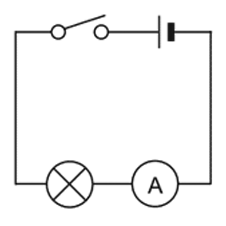physics revision
- Created by: sana
- Created on: 09-05-11 20:55
Producing electricity
There are two types of electric current - direct current (DC) and alternating current (AC).
Direct current - If the current flows in only one direction it is called direct current, or DC. Batteries and solar cells supply DC electricity. A typical battery may supply 1.5V. The diagram shows an oscilloscope screen displaying the signal from a DC supply.
Alternating current - If the current constantly changes direction it is called alternating current, or AC. Mains electricity is an AC supply. The UK mains supply is about 230V. It has a frequency of 50Hz (50 hertz), which means that it changes direction and back again 50 times a second. The diagram shows an oscilloscope screen displaying the signal from an AC supply.
Producing electricity
An electric current can be produced by moving a magnet inside a coil of wire. The size of this induced current can be increased by moving the magnet faster, by using a stronger magnet, or by increasing the number of turns on the coil and increasing its area. A dynamo is a type of electricity generator.
Making electricity
An electric current is produced when a magnet is moved into a coil of wire in a circuit. We say that the electric current has been induced, and the process is called induction.To increase the induced current:
- move the magnet faster
- use a stronger magnet
- increase the number of turns on the coil
- increase the area of the coil
-
Dynamos
It is not practical to generate large amounts of electricity by passing a magnet in and out of a coil of wire. Instead, generators induce a current by spinning a coil of wire inside a magnetic field, or by spinning a magnet inside a coil of wire. As this happens, a potential difference - voltage - is produced between the ends of the coil, which causes a current to flow.
One simple example of a generator is the bicycle dynamo. The dynamo has a wheel that touches the back tyre. As the bicycle moves, the wheel turns a magnet inside a coil. This induces enough electricity to run the bicycle's lights.
The faster the bicycle moves, the greater the induced current and the brighter the lights.
Voltage, current and resistance
Current is measured in amps (A), using an ammeter in series. Voltage is measured in volts (V), using a voltmeter in parallel. There is a relationship between voltage, current and resistance
voltage = current × resistance.
The resistance in a circuit can be increased by adding more components, such as resistors and lamps.
The filament lamp does not follow Ohm's Law.
The resistance of a thermistor changes with temperature, and the resistance of an LDR changes with different light levels. These components are useful for controlling electrical devices.
Current - A current flows when an electric charge moves around a circuit. No current can flow if the circuit is broken.
Measuring current - You need to know how to measure the current that flows through a component in a circuit and the voltage across it. 
current is measured in amperes, amperes is often abbreviated to amps or A current flowing through a component in a circuit is measured using an ammeter, the ammeter must be connected in series with the component - remember, in a series circuit, electrical devices are placed one after the other in a continuous line in the circuit between the positive and negative poles of the battery
Voltage
A voltage across an electrical component - such as a lamp - is needed to make a current flow through it. Cells or batteries often provide the voltage needed.
Measuring voltage
The voltmeter is in parallel with the lamp
Related discussions on The Student Room
- A-Level Physics »
- Science Gcse »
- The order to revise »
- Need help on what to do to improve on my a levels! »
- Bangor University GCSE Revision guides? »
- Where to find practise questions? »
- OCR A A-level Physics Paper 1 Modelling Physics (H556/01) - 24th May 2024 [Exam Chat] »
- AQA A-level Physics Paper 1 (7408/1) - 24th May 2024 [Exam Chat] »
- A-level Physics Study Group 2023-2024 »
- Taking a gap year to retake a levels, tips for getting A/A*? »
Comments
No comments have yet been made